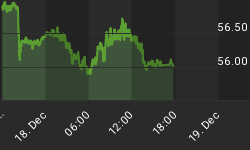Several of the economic indicators that go into our real time recession indicator are starting to point to recession. However, as we have discussed recently, signs of recession over the recent past have not led to recessions and weakness in the equity markets, but rather weakness in the economic indicators have been a sign of Federal Reserve intervention. Of course, this week we all wait for the Fed's latest scheme to bolster asset prices.
Figure 1 shows a weekly chart of the SP500. The red labeled bars are those times when the Economic Cycle Research Institute's Weekly Leading Index (WLI) is below a value of -2.4. When the WLI is below this level, there is a high degree of correlation with a recession. The current value of the WLI is -3. As you can see, WLI has been timely about regarding recession warnings, but over the past 2 years it has done a "stellar" job at identifying the next quantitative easing operation. See this article on distorted market signals.
Figure 1. SP500/ weekly
![]() Larger Image
Larger Image
Figure 2 shows a weekly chart of the SP500, and the red labeled bars are those times when the Philadelphia Federal Reserve's Aruoba-Diebold-Scotti (ADS) business conditions index is signaling recession. The ADS indicator is designed to track real business conditions at high frequency. This recently turned negative on the economy.
Figure 2. SP500/ weekly
![]() Larger Image
Larger Image
So what does all this mean? High frequency and leading indicators are beginning to detect weakness in the economy. At present, there are 6 components that make up my real time recession indicator (RTRI). The ECRI's Leading Index and Leading Index (growth) are showing economic weakness, and the Philly Fed's ADS index is showing weakness. The Chicago Fed's National Activity Index will weigh in next week. The other two components of my RTRI are SP500 price based models, and with the recent 3 week bounce, these models are far from rolling over. In any case, the RTRI uses a consensus approach, and we would require at least 4 components to be negative before expecting a recession.
For now, several independent models are suggesting economic weakness. Whether this leads to a recession will likely be determined around 2:15 pm on Wednesday afternoon following the announcement by the Federal Open Market Committee.















